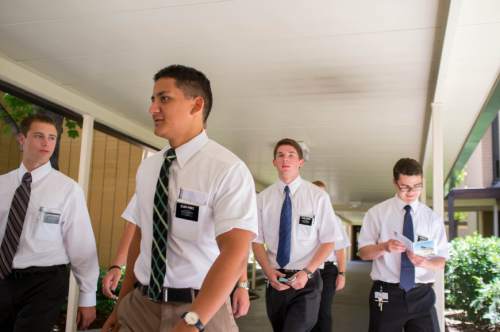This is an archived article that was published on sltrib.com in 2016, and information in the article may be outdated. It is provided only for personal research purposes and may not be reprinted.
It took an extra year, it seems, for the number of Mormon missionaries to settle back into the 70,000s after a post-2012 "surge" swelled the proselytizing ranks to nearly 90,000.
After the Utah-based faith lowered the minimum age for young women and men to serve missions, the worldwide force skyrocketed — from about 58,000 in late 2012 — and surprised everyone by continuing to climb for several years, eclipsing 85,000 at the end of 2014.
This month, however, the number of full-time missionaries has fallen by 12 percent, to 75,000 (still up nearly 30 percent since the age shift).
It's all part of a cycle, LDS Church spokesman Eric Hawkins said Friday. The number of missionaries "does change seasonally."
"There was a peak following the age change, and — as expected — it tapered off a bit after that and then began to climb again," Hawkins said in a statement. "It's now on a steady upward trend, with seasonal peaks expected based on the school year, etc."
To independent Mormon demographer Matt Martinich, that drop in missionary numbers "suggests that the church may be struggling with consistently increasing the number of members serving full-time missions despite the reduced age for missionary service."
Young men now can go out at age 18 (down from 19), and young women can serve at 19 (down from 21).
The church also likely "delayed the organization of additional missions," Martinich wrote on his blog about LDS growth, "as plans for only three new missions have been announced for 2016."
Mormon optimism, though, is inescapable.
In March 2015, LDS apostle Jeffrey R. Holland told a radio interviewer that The Church of Jesus Christ of Latter-day Saints expects to have more missionaries than ever in its global proselytizing force by 2019.
"We're projecting out probably within four years," Holland said at the time, "the base-line number for the missionary force will be something around 100,000."
Martinich is more modest in his assessment.
The researcher, a project manager for the Cumorah Foundation, envisions "a return to steady increases in the number of full-time missionaries serving comparable to the early 2010s."
If that happens, he said, the church "appears likely to exceed 80,000 missionaries within the next one to two years and 90,000 missionaries by 2021."
Such progress would, Martinich said, indicate a much higher percentage of mission-age young adults in the international church choosing to go.
That, he believes, would be an important development for the global faith.
Peggy Fletcher Stack



